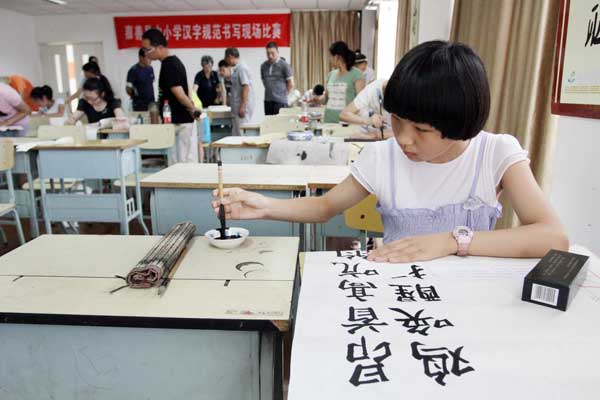

A student takes part in a calligraphy competition in Jiashan county, Zhejiang province, in August. Ten of the 50 participants will go to Jiaxing for a follow-up competition. Hu Lingxiang / for China Daily
China's cultural reach is growing every year -- but is one of its most-treasured traditions under threat on its own shores?
One calligraphy master believes so, and warns that the skill of writing Chinese characters, or hanzi, is being affected by growing reliance on digital technology.
"The style of writing among Chinese people today has been changed or ruined," said Cui Zhiqiang, a senior figure with the China Calligraphers Association.
The 60-year-old said the rapid development and popularity of cellphones and computers mean most people now write Chinese on keyboards using pinyin, words are written in a system which characters are rendered in the Roman alphabet.
A standard Chinese phrase can be written as numbers, symbols or a phonetic translation from English, he said, while netizens also use words that sound the same but are written differently to disguise what they really mean.
"In these ways, the features of a Chinese character, such as its structure and meaning, can be easily forgotten or misunderstood," Cui said. "As a result, many people find they have forgotten how to write a character when picking up a pen and often make mistakes.
"It is an existential crisis for Chinese characters," he added.
The association started holding nationwide calligraphy tests in 2010. Carried out in more than 10 stages, candidates must use hard or soft brushes.
Between 60,000 and 70,000 people register every year, and organizers expect that number to reach more than 100,000 within the next five years.
"These tests are not to train top calligraphers, they are aimed at trying to rescue people's penmanship, which has been ruined by wide use of keyboards," Cui said.
Training teachers
The China Calligraphers Association is also working to train more teachers, to improve professional standards.
In 2011, the Ministry of Education required all primary schools to hold a calligraphy class once a week as well as calling for related courses at high school.
Experts said the move represented concern among educators about the increasing number of students who are losing the ability to correctly write Chinese characters with a brush, or even a pen.
"Shortly after the ministry's stipulation, however, many schools found they did not have enough qualified calligraphy teachers," Cui said. "Many classes had to be taught by physical education teachers."
The association coaches 300 to 400 elementary and middle school teachers in calligraphy each year, and it hopes to have trained 20,000 more in the next three years.
Xu Wei, from Huayuancun No 2 Primary School in Beijing, gained a certificate for teaching calligraphy in June.
"I'm an art teacher, but for many years calligraphy has been a hobby of mine," he said. "I learned how to copy and appreciate the art form for the exam. It's really been useful for my practical teaching."
He said more and more students tend to scribble when they write because they always have lots of homework, which has caused a decline in handwriting. "I believe my calligraphy class helps remind them not to brush off their writing."
Copyright ©1999-2018
Chinanews.com. All rights reserved.
Reproduction in whole or in part without permission is prohibited.